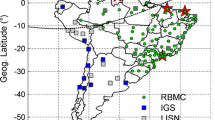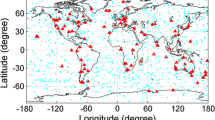The paper proposes an ingenious method for global ionospheric total electron content (TEC) mapping based on a phase-difference approach to the analysis of phase measurements of GNSS signals at a pair of coherent frequencies on a distributed network of ground-based receivers of the global IGS network. The proposed approach uses the representation of the ionosphere as a thin layer with the TEC distribution given by a truncated expansion into a series of spherical harmonics in the Sun-synchronous geomagnetic coordinate system. The expansion coefficients are determined by the least squares technique with a TEC positivity constraint, which is implemented by solving the corresponding linear complementarity problem. The proposed method does not require estimation of the differential code biases of both satellites and receivers, which makes it possible to combine data from various GNSS, such as GPS, GLONASS, and Galileo, within a single algorithm. The results of testing the proposed method on synthesized observation data using the real geometry of GNSS satellites, IGS receivers, and the ionosphere given by the NeQuick2 model, are presented. The results of comparing the real global ionospheric maps obtained by the proposed method and the maps of the CODE center are reported.
Similar content being viewed by others
References
É. L. Afraimovich and N. P. Perevalova, GPS Monitoring of the Earth’s Upper Atmosphere [in Russian], State Institution “Scientific Center for Plastic and Reconstructive Surgery of the East-Siberian Scientific Center of the Siberian Branch of the Russian Medical Academy of Sciences,” Irkutsk (2006).
M. Hernández-Pajares, J. M. Juan, J. Sanz, et al., J. Geod., 83, Nos. 3–4, 263–275 (2009). https://doi.org/10.1007/s00190-008-0266-1
T. L. Gulyaeva and I. Stanislawska, Ann. Geophys., 26, No. 9, 2645–2648 (2008). https://doi.org/10.5194/angeo-26-2645-2008
I. A. Nesterov, E. S. Andreeva, A. M. Padokhin, et al., GPS Solut., 21, No. 4, 1679–1694 (2017). https://doi.org/10.1007/s10291-017-0646-1
T. L. Gulyaeva, F. Arikan, M. Hernández-Pajares, and I. Stanislawska, J. Atmos. Solar. Terr. Phys., 102, 329–340 (2013). https://doi.org/10.1016/j.jastp.2013.06.011
N. Jakowski, C. Mayer, M. M. Hoque, and V. Wilken, Radio Sci ., 46, No. 6, RS0D18 (2011). https://doi.org/10.1029/2010RS004620
A. V. Zhukov, Y. V. Yasyukevich, and A. E. Bykov, GPS Solut., 25, No. 1, 19 (2021). https://doi.org/10.1007/s10291-020-01055-1
D. Roma-Dollase, M. Hernández-Pajares, A. Krankowski, et al., J. Geod., 92, No. 6, 691–06 (2018). https://doi.org/10.1007/s00190-017-1088-9
S. Schaer, “Mapping and predicting the Earth’s ionosphere using the global positioning system,” PhD thesis, Bern (1999).
Y. V. Yasyukevich, A. A. Myl’nikova, V. E. Kunitsyn, and A. M. Padokhin, Geomagn. Aeron., 55, No. 6, 763–769 (2015). https://doi.org/10.1134/S001679321506016X
A. Komjathy, B. Wilson, T. Runge, et al., in: Proc. ION National Technical Meeting, January 28–30, 2002, San Diego, USA.
J. Feltens, Space Weather, 5, No. 12, 1–17 (2007). https://doi.org/10.1029/2006SW000294
E. S. Andreeva, V. E. Kunitsyn, and E. D. Tereshchenko, Ann. Geophys., 10, Nos. 11–12, 849–855 (1992).
M.Hernández-Pajares, J. Juan, and J. Sanz, J. Atmos. Sol. Terr. Phys., 61, No. 16, 1237–1247 (1999). https://doi.org/10.1016/S1364-6826(99)00054-1
V. E. Kunitsyn, I. A. Nesterov, A. M. Padokhin, et al., J. Commun. Technol. Electron., 56, No. 11, 1269–1281 (2011). https://doi.org/10.1134/S1064226911100147
I. A. Nesterov and V. E. Kunitsyn, Adv. Space Res., 47, No. 10, 1789–1803 (2011). https://doi.org/10.1016/j.asr.2010.11.034
K. M. Laundal and A. D. Richmond, Space Sci. Rev., 206, 27–59 (2017). https://doi.org/10.1007/s11214-016-0275-y
K. Rawer, in: B. Landmark, ed., Meteorolog. Astronom. Influences Radio Wave Propag., Pergamon Press, Oxford (1963).
H. Zhang, P. Xu, W. Han, et al., Adv. Space Res., 51, No. 6, 988–1000 (2013). https://doi.org/10.1016/j.asr.2012.06.026
F. Azpilicueta, C. Brunini, and S. M.Radicella, Adv. Space Res., 38, No. 11, 2324–2331 (2006). https://doi.org/10.1016/j.asr.2005.07.069
B. Hofmann-Wellenhof, H. Lichtenegger, and E. Wasle, GNSS—Global Navigation Satellite Systems: GPS, GLONASS, Galileo, and more, Springer, Vienna (2008).
A. Savitzky and M. J. E. Golay, Anal. Chem., 36, No. 8, 1627–1639 (1964). https://doi.org/10.1021/ac60214a047
P. Alken, E. Thébault, C. D. Beggan, et al., Earth, Planets Space, 73, 49 (2021). https://doi.org/10.1186/s40623-020-01288-x
G.H. Golub and M.A. Saunders, in: J. Abadie, ed., Integer and Nonlinear Programming, North-Holland, Amsterdam (1970), pp. 229–256.
K. G. Murty, Linear Complementarity, Linear and Nonlinear Programming, Heldermann, Berlin (1988).
C. E. Lemke, in: G. B. Dantzig and A. F. Veinott, eds., Mathematics of the Decision Sciences, Amer. Math. Soc., Rhode Island (1968), pp. 95–114.
Y. Yasyukevich, A. Mylnikova, and A. Vesnin, Sensors, 20, No. 19, 5702 (2020). https://doi.org/10.3390/s20195702
B. Nava, P. Coisson, and S. M. Radicella, J. Atmos. Sol. Terr. Phys., 70, No. 15 (2008). https://doi.org/10.1016/j.jastp.2008.01.015
Author information
Authors and Affiliations
Corresponding author
Additional information
Translated from Izvestiya Vysshikh Uchebnykh Zavedenii, Radiofizika, Vol. 65, No. 7, pp. 527–543, July 2022. Russian DOI: https://doi.org/10.52452/00213462_2022_65_07_527
Rights and permissions
Springer Nature or its licensor (e.g. a society or other partner) holds exclusive rights to this article under a publishing agreement with the author(s) or other rightsholder(s); author self-archiving of the accepted manuscript version of this article is solely governed by the terms of such publishing agreement and applicable law.
About this article
Cite this article
Padokhin, A.M., Andreeva, E.S., Nazarenko, M.O. et al. Phase-Difference Approach for GNSS Global Ionospheric Total Electron Content Mapping. Radiophys Quantum El 65, 481–495 (2022). https://doi.org/10.1007/s11141-023-10230-6
Received:
Accepted:
Published:
Issue Date:
DOI: https://doi.org/10.1007/s11141-023-10230-6




